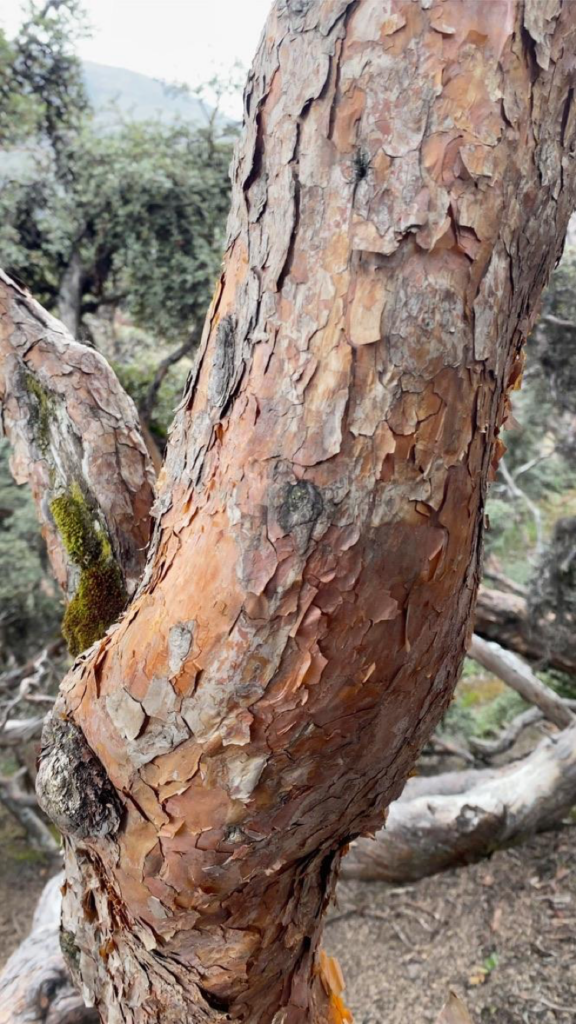Originally published 3/7/23 on https://isabelavalencia.com/a-lesson-from-ancient-polylepis-trees/

A couple weeks ago, I wandered the Polylepis forest in the Chimborazo Park Reserve. After a two-hour trek through the sandy trail, passing by vicuna animals and native Andean shrubs, I saw the entrance. The sight of the trees with their branches reaching out in all directions struck me.
The trees had an eldritch air about them. Their contorted limbs were draped ethereally, like the frayed fabric of some otherworldly specter. Though the height of this tree species was unimpressive, what’s remarkable was the breadth of these branches, how they extend their arms into the world, giving and giving. What secrets do these ancient trees bear – about perseverance and resilience, weathering tough times?
Once upon a time, Polylepis forests covered the high Andes; today, only a few forests remain in Ecuador. Entering a forest of Polylepis trees is like walking back in time. The dancing shadows and the silence make it easy for wild imaginations to take flight. Even during a heavy rain, few drops penetrate the canopy. And when low-lying clouds roll in, the forest feels ominous.

Paper bark hangs from limbs, almost begging to be pulled away like chapped skin on dry lips. The knots are gnarly, and the forest floor feels spongy under your feet. If you reach out to feel a branch, your fingers will sense the papery-thin coolness on the surface.

Polylepis trees’ haunting and twisted shapes serve a purpose. According to research, Polylepis are storm resistant, their structures adeptly preserving their vitality. Because their branches and trunks are spiraled, they can flex in the wind rather than break. Their leaves follow a similar strategy: when hit with wind, they curl into a Fibonacci spiral, thereby allowing the air to pass through rather than rip them off. What unfolds beneath the surface is even more fascinating: below ground, the trees’ roots reach out for each other, limbs forming a lattice of unseen support. When a storm strikes one tree, it strikes them all. In other words, they hold each other down.

Research suggests that climate change can drive a significant loss of habitat for the tree species. As a result of logging, climate change, and other human activities, only 10% of the original Polylepis forest cover remains, making it one of the most endangered forested ecosystems in the world. For generations, Indigenous peoples have used the wood to heat homes, cook food and make wooden handles for tools. They also use Polylepis bark to dye cloth and to help treat respiratory illness and kidney disease.
Safeguarding these trees is crucial to preserving vital ecosystems and supporting the communities that depend on them. Polylepis forests that once covered much of the land provide a habitat to birds and other native wildlife and absorb mist from the clouds to bring much needed water to the Sacred Valley. Polylepis forests not only attract endangered birds and diverse wildlife but also absorb and store substantial amounts of water from the Andean clouds. This keeps the soils around them healthy, and mountain streams flowing.
Today, native Polylepis forests are being restored by Indigenous communities in the Andes Mountains. As with so many environmental issues, it will take hard work and education to save the trees that still exist.
Given sufficient human support, I strongly believe these trees will weather any storm. How can they not when they show such incredible natural resiliency—freely extending out their knotted limbs, sheltering while knitting their roots together below?
Perhaps we can all take a page out of the Polylepis’ book on how to live our lives—like their roots, we reach for support, no matter the conditions of our environment. The innate resiliency of Polylepis trees comes not from their capacity to stand tall, but wide, together. Branches stretching out, crowns seeking community over conquest. Sprouts emerging from slices, with fresh wood springing from old wounds. Leaves swirling in the wind, allowing its passage with little resistance.
Storms are always going to come. But together, we can weather them.